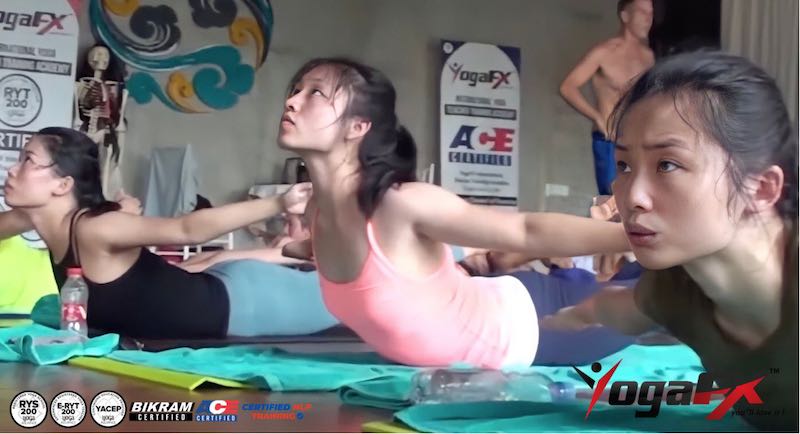How many calories does Bikram yoga burn: when your body enters a hot/humid environment, your body’s natural cooling system kicks in.
How many hot yoga burning calories? Even if you aren’t moving around you will start to sweat, like you would if you were sitting in a sauna. You are dripping sweat and your body’s natural instincts are going to kick in and tell you that you are working too hard. But you push yourself, you finish the class, and you feel like you just kicked yoga’s butt and vice/versa.
Yoga’s mentally taxing nature coupled with high perceived (not actual) exertion is what makes hot yogis think that they are getting the most efficient workout possible. It’s much easier to run on a treadmill with headphones on, the TV blaring, and a magazine in front of your face than to concentrate on acute posture modifications while holding strenuous poses. If you weigh 150 lbs and jog on the treadmill for an hour (60 min) at 7 mph for one hour, you will burn 800 calories.
Yes, working out in a hot and humid room does increase calorie expenditure, about 10 extra calories per hour per 9 degrees of increase. So if you are doing gentle Hatha-style yoga in a 70-degree room for sixty minutes, you will burn 189 calories. Crank the heat up to 88 degrees, and you will burn 209 calories. Do you know what else burns 20 calories a whole lot quicker and without as much mental anguish? Walking up 4 flights of stairs.
Here’s a look at calories burned for hot yoga based on style and duration:
Hatha (Gentle) Yoga: 189 cal ( 60 minutes ), 284 cal ( 90 Minutes )
Vinyasa Flow or Power Yoga: 594 cal ( 60 Minutes ), 891 cal ( 90 Minutes )
Hot Hatha or Bikram: 477 cal ( 60 Minutes ), 716 cal ( 90 Minutes )
Hot Power Yoga: 620 cal ( 60 Minutes ), 930 cal ( 90 Minutes )
*all measurements based on 150-lb. female.
How many hot yoga burns calories? Yoga in general (Hatha, gentle, yin/yang, restorative) is one of the least efficient ways of burning calories. Plus, studies have shown yoga to slow the metabolism causing your body to become less efficient at calorie burn for hot yoga on your own. In The Healthiest You by Kelly Traver, M.D., general yoga is considered a light exercise that will burn fewer calories than “heavy house cleaning” and gardening. It ranks a little higher than bowling and “golfing with a cart”.
If you are trying to lose weight, yoga-like any form of exercise — can definitely help. Vinyasa yoga or power yoga is probably the best form if you are looking to use yoga to lose weight efficiently. For weight loss, skip the heat. It causes dehydration and exhaustion. You will be less likely to sustain high activity throughout your day if you wear yourself down in the morning with a hot yoga class.
Your Target Heart Rate
Knowing where your heart rate should be is essential to effectively monitor it during a Bikram yoga class. You can calculate your maximum heart rate by subtracting your age from 220. Your heart rate during a hot yoga session should be only a percentage of that number. Falling into a zone between 55 and 90 percent. Periodically during class, at least once or twice, take your pulse for 15 seconds, either on your throat or wrist. If your heart rate is in your target zone but you wonder if it’s still a little high. stop exercising and see how quickly it slows back down. Timothy McCall of “Yoga Journal” says your heart rate should return to almost normal within minutes of stopping exercise.
Acclimate for Safety
The risk of suffering damage to your heart, because of a dangerously elevated heart rate during Bikram yoga can be minimized if you acclimate yourself to exercising in a heated environment. Cedric X. Bryant, Ph.D., of the American Council on Exercise. recommends that you gradually ease your body into Bikram yoga by limiting your first session to 10 or 15 minutes. Over 10 to 14 days, you’ll slowly work up to 20 to 60 minutes or more. Bryant warns that you’ll quickly become de-acclimated, though, by taking days off from Bikram yoga.
Cautions
Practice Bikram yoga carefully to reduce your chances of negatively affecting your heart. Drink water during class, taking in 16 ounces before class, and continuing hydration with roughly 30 ounces after class. Stop working out if you feel dizzy, nauseated, crampy, or fatigued. Rapid heartbeat, weakness, and blurry vision are other signs that should cause concern. If you experience any distress while practicing Bikram yoga. find a cool area outside the room, lie down with your feet elevated, and apply cool cloths to your forehead, arms, and legs. If you have a medical condition like heart-related illness, respiratory disease, diabetes, or another ailment. Bikram yoga could be a dangerous form of exercise for you.
CLICK HERE For More Course Inclusions and Our June Main Event



